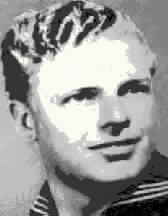Hutchins was assigned the the USS LST-473 (LST-473) - tank landing ships being built so fast and so numerous there wasn't time or priority to actually give them names. On September 4, 1943, LST-473 transported Australian soldiers as part of the invasion fleet for the landings at Lae on New Guinea as part of the Salamaua-Lae Campaign.
As the ships approached shore with their assault troops, they came under attack from shore fires and Japanese aircraft, both level and torpedo bombers. LST-473 was struck in its pilot house and bridge area by a bomb. At that moment, an air-dropped torpedo was also making its way towards the now stricken landing ship. Johnnie Hutchins lay mortally wounded from the bomb blast, but it fell to him to steer his ship to safety out of the path of the torpedo. His final act placed him in the ranks of our nation's most honored heroes.
From Medal of Honor Citations for World War II (G-L):
*HUTCHINS, JOHNNIE DAVID
Rank and organization: Seaman First Class, U.S. Naval Reserve. Citation: For extraordinary heroism and conspicuous valor above and beyond the call of duty while serving on board a Landing Ship, Tank, during the assault on Lae, New Guinea, 4 September 1943. As the ship on which Hutchins was stationed approached the enemy-occupied beach under a veritable hail of fire from Japanese shore batteries and aerial bombardment, a hostile torpedo pierced the surf and bore down upon the vessel with deadly accuracy. In the tense split seconds before the helmsman could steer clear of the threatening missile, a bomb struck the pilot house, dislodged him from his station, and left the stricken ship helplessly exposed. Fully aware of the dire peril of the situation, Hutchins, although mortally wounded by the shattering explosion, quickly grasped the wheel and exhausted the last of his strength in maneuvering the vessel clear of the advancing torpedo. Still clinging to the helm, he eventually succumbed to his injuries, his final thoughts concerned only with the safety of his ship, his final efforts expended toward the security of his mission. He gallantly gave his life in the service of his country.
Hutchins was initially buried on New Guinea. After the war, his remains were repatriated to the United States and he today rests in peace at the Lakeside Cemetery in Eagle Lake, Texas.
Another crewman received the Navy Cross for his own heroism in steering LST-473 to safety after Hutchins perished. He was Seaman First Class Frederick L. Erickson, and his citation is courtesy of Military Times' Hall of Valor:
The President of the United States of America takes pleasure in presenting the Navy Cross to Seaman First Class Frederick Luther Erickson, United States Naval Reserve, for extraordinary heroism and devotion to duty in action against the enemy while serving as Helmsman aboard U.S.S. LST FOUR HUNDRED SEVENTY-THREE (LST-473), during operations against Lae, New Guinea, on 4 September 1943. Seaman First Class Erickson was severely wounded by the impact of a direct bomb hit which blew him out of the pilot house. Upon recovering consciousness he returned to his battle station, and, despite acute pain and waning strength, gamely endeavored to hold the stricken ship on her course until he was relieved by one of his shipmates. The conduct of Seaman First Class Erickson throughout this action contributed in large measure to the outstanding success of these vital missions and reflect great credit upon the United States Naval Service.
According to the Department of Veterans' Affairs Grave Locator, S1C Erickson survived the war and passed away at age 77 on October 25, 1997.
Two other LST-473 crewmembers received the Silver Star for valor during the Lae landing operation. They were Chief Pharmacist's Mate Nelson Tudor and Ensign J. K. Hayes.
LST-473's damage was repaired, and the vessel continued to serve throughout the remainder of the war in the Pacific and participated in the various landing operations to recapture the Philippines in 1944-45. She received five battle stars for her service and was decommissioned post-war and sold for scrap in 1948.
Less than a year after S1C Hutchins' heroic sacrifice, the lost sailor's mother was the sponsor for the USS Johnnie Hutchins (DE-360) as the ship was commissioned into service on August 28, 1944. The Hutchins, a John C. Butler-class destroyer escort, made it to combat in the Pacific by early 1945 and was commended for her pursuit and sinking of two or three Japanese midget submarines near Okinawa on August 9, 1945 - the day an atomic bomb was dropped on Nagasaki, Japan. The Hutchins was kept in reserve after the war and made several cruises for reservist training purposes. The ship was decommissioned to inactive reserve in 1958, and remained in that status until she was struck from the Navy List in 1972 and sold for scrapping two years later.




No comments:
Post a Comment
COMMENTS ARE CLOSED. NO ADDITIONAL COMMENTS WILL BE POSTED HERE. IF YOU WISH TO COMMENT, PLEASE GO TO THE NEW BLOG SITE – http://theirfinesthour.net – AND LEAVE YOUR FEEDBACK THERE!!!
Note: Only a member of this blog may post a comment.